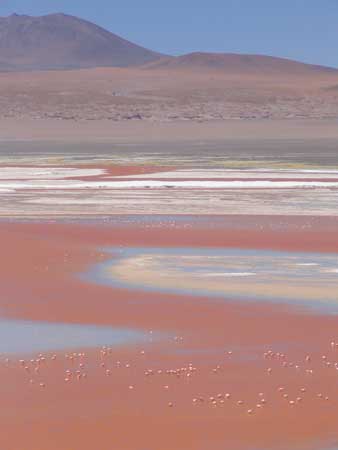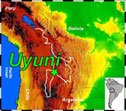|
Day 3: "Did I mention it's freezing??"
Kristen Ebert

Flamingoes cluster in Laguna Colorado at over 5000m elevation (More Day 3!)
|
Culture - Salar de Uyuni
Culture within the great Salar de Uyuni is not like any other in Bolivia. There is a complete transition from the mingling gringo amongst the Bolivians to the single Bolivian carting around a Land Rover full of gringos and all their unnecessary travel gear.
The Salar de Uyuni is one of the largest tourist attractions in the country, outside of the main Bolivia cities, such as La Paz, Potosi, and Sucre.
When venturing into the Salar Region, you will first find yourself in the small town of Uyuni, a small salt mining community, most of which is tainted by the extreme amount of tourists and tour companies, whose "prices are subject to change without notice" -Brian Horton.
Uyuni serves as the tourist headquarters to handle the non-stop flow of gringo traffic through the region, though most gringos are shipped in and out of the area within a 3-4 day period, making an appearance on the streets of Uyuni only just before and after their Land Rover journey across the Salar and through the volcanic chain which serves as the border between Chile and Southern Bolivia.
Eating in Uyuni, again, taught us a valuable Bolivian lesson - no matter how few people are in the restaurant before you, you most likely won't be served for at least 2 hours after arrival. Don't arrive hungry; arrive early, with the intention of being hungry within the next few hours.
As with any other city, Uyuni has the food markets, the narrow streets filled with street vendors, the shoe-shine boys, and the 6-year old girls selling hand sewn finger puppets. In Uyuni, the persistency of the salespeople is less dominant as those in larger cities, and they seem less willing to chase you down the street given the opportunity that they catch you scoping out their hand made goods, such as mini salt llamas:
"The last ramshackle village before voyaging into the great white unknown has the best damn salt figurines in the whole wide world." - Bobby Gillis
|

